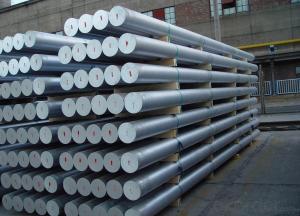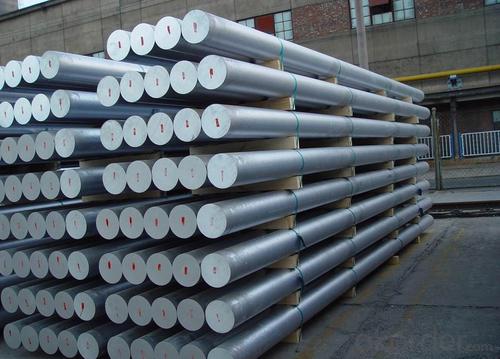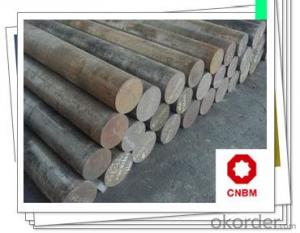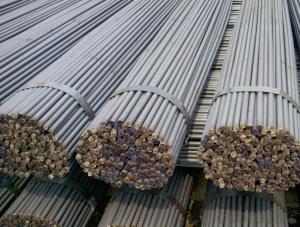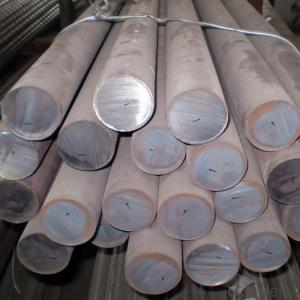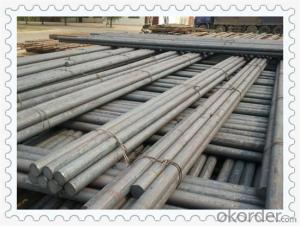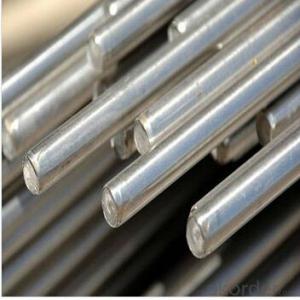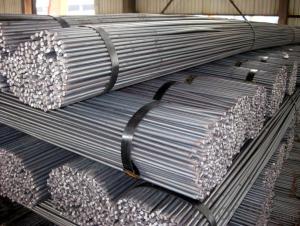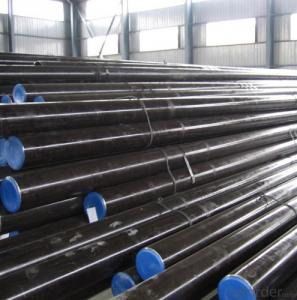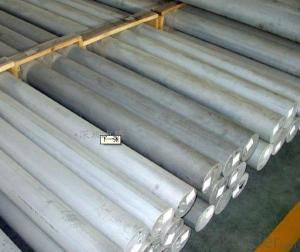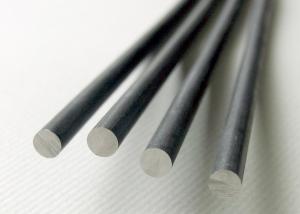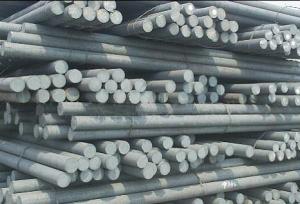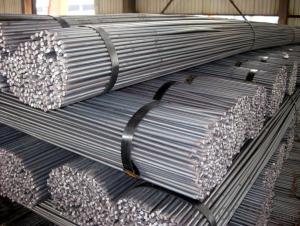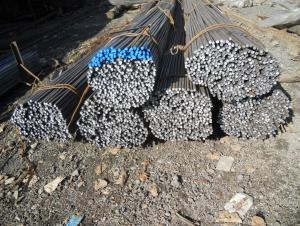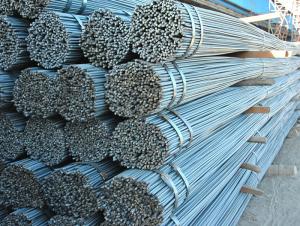Spring And Bearing Steel Of Round Bar Shape
- Loading Port:
- China main port
- Payment Terms:
- TT OR LC
- Min Order Qty:
- 25 m.t.
- Supply Capability:
- 5000 m.t./month
OKorder Service Pledge
OKorder Financial Service
You Might Also Like
Grade | AISI 52100, ASTM E52100, DIN 1.3505,JIS SUJ2, GCr15 |
Dimensions | Diameter: 30-60mm Length: 2000-13000mm or as required |
Shape | Round Bar |
Type | Alloy Steel Bar |
Delivery Condition | Black Surface |
Material | Bearing Steel |
Technique | Hot Rolled |
Usage and Applications
These steels are used for ball and roller bearing applications and are comprised of low carbon steels and high carbon through harden able steel.
First the famous 1C-1.5Cr steel from which the majority of bearings are made. Its structure is apparently well-understood and the focus is on purity in order to avoid inclusions which initiate fatigue during rolling contact. Then there is the M50 steel and its variants, from which bearings which serve at slightly higher temperatures in aeroengines are manufactured, based on secondary-hardened marten site.
Tapered roller bearing are generally used to support combined load mainly consisting of radial load. Their cups are separable for easy assembling ,During mounting and using, radial clearance and axial clearance can be adjusted and preloaded mounting can be made.
Packaging & Delivery
Packaging Detail: ASTM 52100 Steel in seaworthy packing or on customer request; Packed in bundles with standard export sea-worthy package or as customer require
Delivery Detail: 45 days after confirmed
Trade terms: FOB, CFR, CIF ou as customer's required
MOQ: 25 tons or at customer's demands. If the quantity is good, the price will be better.
Processing of Bearing Steel Round Bar
The processing of Bearing Steel Round Bar is hot rolled (strictly control sulphur, phosphorus and non-metallic inclusions content and distribution)
Chemical Composition of Bearing Steel Round Bar
C | Si | Mn | Cr | Ni | Cu |
Equal or less than | |||||
0.95-1.05 | 0.15-0.35 | 0.25-0.45 | Cr:1.40-1.65 | 0.30 | 0.25 |
All products' chemical composition and specification can be design according to customers' requirement.
Note
1. According to national standard (GB) for our products, if not, supply according to national standards (GB) or agreement.
2. We can not only provide electric furnace +LF+VD and electros lag re-melting (ESR) steel forging materials, but also forging products of piece, bar, etc.
3. Our company is equipped with roll equipment and can provide our customers with roll billets or finished.
4. Please send us your detailed specifications when inquire. We will reply to you ASAP.
5. Certificate of quality is issued in English, in addition the normal terms, production process, the mechanical property (yield strength, tensile strength, elongation and hardness. forged ratio, UT test result, Grain size, heat treatment methods and the sample of is shown on the certificate of quality.
- Q: What are the different types of steel round bar alloys used in the aerospace industry?
- In the aerospace industry, various steel round bar alloys are commonly used to meet the specific demands of different applications. These alloys have been specifically designed to meet the rigorous requirements of the aerospace sector, including the need for high strength, corrosion resistance, and lightweight properties. 1. Stainless Steel: Among the alloys used in aerospace applications, stainless steel stands out as one of the most popular choices. It possesses excellent corrosion resistance, high strength, and good heat resistance. Aircraft components like landing gear, fasteners, and engine parts often employ this alloy. 2. Titanium Alloy: Due to its exceptional strength-to-weight ratio, titanium alloys find widespread use in the aerospace industry. They offer excellent corrosion resistance, good fatigue strength, and can withstand high temperatures. Aircraft frames, engine components, and landing gear often utilize titanium alloys. 3. Aluminum Alloy: Aerospace applications benefit from the lightweight nature and excellent mechanical properties of aluminum alloys. These alloys possess good corrosion resistance and are commonly used in aircraft structures, wings, and fuselage components. 4. Nickel Alloy: Known for their high strength and exceptional resistance to extreme temperatures, nickel alloys are frequently employed in aerospace applications. They are critical in environments requiring resistance to heat, wear, and corrosion, such as turbine engines and exhaust systems. 5. High-Strength Low-Alloy (HSLA) Steel: HSLA steels are renowned for their high strength and weldability. They offer good toughness and impact resistance, making them ideal for aerospace applications where durability and strength are essential, such as in landing gear and structural components. In summary, the aerospace industry employs a combination of these steel round bar alloys to cater to the specific requirements of different components and applications. Each alloy possesses unique properties that render it suitable for specific aerospace applications, ensuring the safety, reliability, and performance of aircraft in the demanding aerospace environment.
- Q: Can steel round bars be used for making exhaust systems?
- Indeed, exhaust systems can be fabricated using steel round bars. Steel, being renowned for its endurance, resistance to heat, and capacity to endure extreme temperatures and harsh surroundings, is widely favored as a material for exhaust systems. By utilizing steel round bars, one can fashion the pipes, mufflers, and other constituents of an exhaust system. Moreover, these bars can be readily welded and molded into the preferred shape, enabling customization and design flexibility. Furthermore, steel round bars can furnish the essential strength and structural soundness imperative for an effective and enduring exhaust system.
- Q: What is the tolerance level for steel round bars?
- The tolerance level for steel round bars can vary depending on several factors such as the grade and diameter of the bar, as well as the specific industry standards and requirements. Generally, the tolerance level for steel round bars is specified in terms of diameter or diameter deviation. For example, in the manufacturing industry, the tolerance level for steel round bars can be specified as a specific diameter range, such as +/- 0.001 inches or +/- 0.02 millimeters. This means that the actual diameter of the bar should be within this specified range to meet the tolerance requirements. Additionally, the tolerance level can also be specified in terms of diameter deviation, which refers to the difference between the actual diameter of the bar and the specified nominal diameter. This deviation is usually expressed as a percentage or a specific measurement, such as +/- 0.5% or +/- 0.010 inches. It is important to note that the tolerance level for steel round bars can be more stringent in certain industries, such as aerospace or automotive, where precision and quality are critical. In these cases, the tolerance requirements may be narrower to ensure the bar meets the specific performance and safety standards. Ultimately, it is essential to consult the relevant industry standards, specifications, or customer requirements to determine the specific tolerance level for steel round bars in a particular application.
- Q: Can steel round bars be used in the energy industry?
- Yes, steel round bars can be used in the energy industry. Steel round bars are commonly used in various applications within the energy industry due to their high strength, durability, and resistance to corrosion. They are used in the construction of power plants, oil rigs, pipelines, and other energy infrastructure projects. Steel round bars are also used in the manufacturing of machinery and equipment used in the energy industry, such as turbines, generators, and pumps. Additionally, steel round bars are often utilized in the production of renewable energy technologies, including wind turbines and solar power systems. Overall, steel round bars are a versatile and reliable material that can effectively meet the demanding requirements of the energy industry.
- Q: Are steel round bars resistant to chemicals?
- The resistance of steel round bars to chemicals can vary depending on the specific steel type and the chemicals involved. Stainless steel round bars are well-known for their exceptional resistance to a wide range of chemicals, including acids, alkalis, and various organic compounds. This is because stainless steel contains high levels of chromium, which creates a protective oxide layer on the surface, preventing corrosion and chemical attacks. However, not all steel round bars possess the same level of chemical resistance. Carbon steel round bars, for example, are more prone to corrosion and chemical attacks compared to stainless steel. Corrosive chemicals, especially in highly corrosive environments, can affect carbon steel and cause damage. In such cases, it may be necessary to use additional protective measures, such as coatings or treatments, to enhance the chemical resistance. To summarize, stainless steel round bars provide excellent chemical resistance, whereas carbon steel round bars may require extra precautions to prevent chemical corrosion. When assessing the chemical resistance of steel round bars, it is crucial to consider the specific steel type, the type of chemical, and the environmental conditions.
- Q: What are the different mechanical properties of steel round bars?
- The different mechanical properties of steel round bars include tensile strength, yield strength, elongation, hardness, and impact resistance. Tensile strength refers to the maximum amount of stress a material can withstand before breaking. Yield strength is the stress at which a material begins to deform permanently. Elongation measures the amount of deformation a material can undergo before breaking. Hardness determines the material's resistance to indentation or scratching. Impact resistance is the ability of a material to absorb energy during sudden impacts without breaking.
- Q: What are the advantages of using nickel-chromium alloy steel round bars?
- There are several advantages of using nickel-chromium alloy steel round bars in various applications. Firstly, nickel-chromium alloy steel round bars have excellent corrosion resistance properties. The presence of nickel and chromium elements in the alloy enhances its ability to resist corrosion from various environmental factors such as moisture, chemicals, and oxidation. This makes these round bars suitable for use in challenging environments such as marine applications, chemical processing plants, and oil refineries. Secondly, nickel-chromium alloy steel round bars offer high temperature resistance. The combination of nickel and chromium elements in the alloy allows it to withstand elevated temperatures without losing its structural integrity. This makes them suitable for use in heat exchangers, furnaces, and other high-temperature applications. Additionally, nickel-chromium alloy steel round bars have superior mechanical properties. They exhibit excellent strength, toughness, and wear resistance, making them ideal for applications that require high load-bearing capabilities. These round bars also exhibit good ductility, allowing for ease of machining and fabrication. Moreover, nickel-chromium alloy steel round bars have good electrical conductivity. This makes them suitable for electrical and electronic applications where conductivity is essential, such as in the manufacturing of resistors, heating elements, and electrical connectors. Lastly, nickel-chromium alloy steel round bars are readily available and cost-effective. As a widely used material in various industries, these round bars are easily accessible and can be obtained at competitive prices. In summary, the advantages of using nickel-chromium alloy steel round bars include excellent corrosion resistance, high-temperature resistance, superior mechanical properties, good electrical conductivity, and cost-effectiveness. These characteristics make them a preferred choice for a wide range of applications in industries such as construction, automotive, aerospace, and electrical engineering.
- Q: Use of stainless steel round bar
- Stainless steel round bar is a kind of long material, and it is also a kind of bar. The so-called stainless steel round bar refers to the cross section is even round long material, generally about four meters long.
- Q: How do steel round bars compare to brass round bars?
- Steel round bars and brass round bars possess distinct characteristics that make them suitable for different purposes. To begin with, steel round bars exhibit superior strength and durability in comparison to brass round bars. Steel boasts a higher tensile strength, rendering it ideal for applications demanding resistance against heavy loads. Consequently, it finds extensive usage in the construction, manufacturing, and automotive sectors, where strength and durability play pivotal roles. On the other hand, brass round bars are renowned for their exceptional corrosion resistance and electrical conductivity. As an alloy of copper and zinc, brass acquires a unique amalgamation of properties. It frequently finds application in scenarios necessitating good electrical conductivity, such as electrical connectors, plumbing fittings, and musical instruments. Moreover, brass possesses an appealing golden appearance, making it a favored choice for decorative purposes. In terms of cost, steel round bars generally prove more economical than their brass counterparts. Steel enjoys widespread availability and substantial production, resulting in lower unit costs. Conversely, brass, as a copper alloy, being a relatively expensive metal, typically carries a higher price tag. Another crucial aspect to consider is machinability. Steel round bars typically prove more manageable and workable than brass round bars. Steel exhibits favorable cutting and drilling properties, thereby facilitating the fabrication of diverse shapes and sizes. Conversely, brass tends to boast a higher machinability rating, indicating its ease of cutting and shaping compared to other metals. In conclusion, steel round bars surpass brass round bars in terms of strength, durability, and cost-effectiveness. They serve as suitable components for applications necessitating robustness and resistance against heavy loads. Conversely, brass round bars excel in offering exceptional corrosion resistance, electrical conductivity, and an aesthetically pleasing appearance. They commonly find use in applications demanding high electrical conductivity and for decorative purposes. Ultimately, the choice between steel and brass round bars hinges upon the specific requirements of the given application.
- Q: What is the difference between steel and flat steel, round steel and steel?
- In fact, for the processing of raw materials are the same, is used when the roller rolling pressure is not the same, there are many different types of tooth roller shaft, can produce different steel, the steel section is square, round cross section is round
Send your message to us
Spring And Bearing Steel Of Round Bar Shape
- Loading Port:
- China main port
- Payment Terms:
- TT OR LC
- Min Order Qty:
- 25 m.t.
- Supply Capability:
- 5000 m.t./month
OKorder Service Pledge
OKorder Financial Service
Similar products
Hot products
Hot Searches
Related keywords
